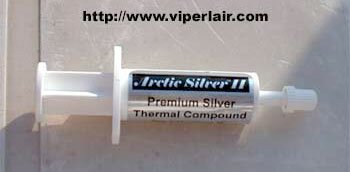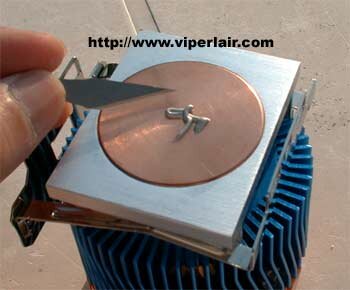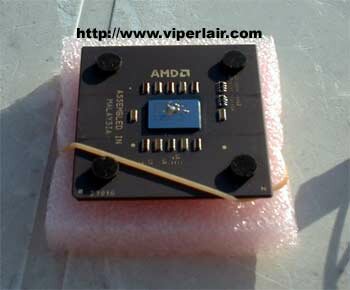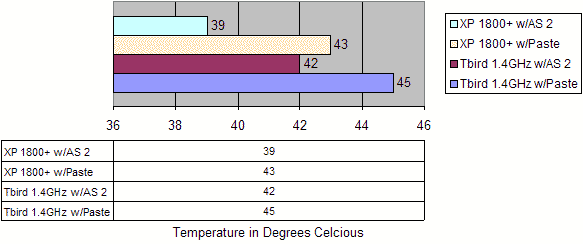|
Written By:
Date Posted: October 29, 2001

No doubt that all of you have heard of Arctic Silver. This was, if I remember correcty, the first high performance heatsink compound available. Back in the days of 1999, most heatsinks came with a thermal pad pre-applied to the bottom. It did the job of filling in all the microcrevices present on your heatsink and CPU. This was important, because if the two surfaces don't meet correctly, cooling isn't optimized. Here is a poor artist rendition on my part...
No Thermal Paste/Pad Applied

Thermal Paste/Pad Applied

So, the whole point of a thermal interface is to help better bond two surfaces together. Without any air gaps, heat will not be trapped, and your cooling efficiency should improve. Although a thermal pad is better than nothing at all, it wasn't always the best solution. In most cases, the thermal conductivity wasn't so hot (get it? hehe, sometimes I kill myself :P). This wasn't too much of an issue back then, because CPUs didn't get terribly hot. With todays CPUs, and even video cards, a better solution was needed.
One problem with thermal pads were that they were too thick. You only needed to fill in tiny gaps, so the use of thermal paste became popular. Radio Shack paste was very popular, due to the price (it was cheap), and on average, it was 3C - 5C more efficient than the pad. Yup, things were looking mighty fine for the mighty thermal paste.
Then came Arctic Silver, which was also a thermal paste, but containing some silver to aid in cooling. Did having some silver help in cooling? It sure did, or at least, that's what I've seen/heard others say. I've never used the original AS, but I made sure I picked myself up some AS II. You're going to pay a little more for AS II (though not as much as the original), but for some, the reported extra performance may be worth it.
Specifications
Made with 99.8% pure micronized silver.
78% to 82% silver content by weight.
Extended temperature limits: 40°C to >160°C
New formula insures minimal viscosity change from 0C to 150C
Thermal conductivity: 8.4 W/m°K to 8.8 W/m°K (Hot Wire Method Per MIL-C-47113)
Thermal Resistance: 0.0028°C-in²/Watt (0.001 inch layer)
2 to 7 degrees centigrade lower CPU core temperatures than other thermal compounds.
Negligible electrical conductivity. Arctic Silver II was formulated to conduct heat, not electricity. It is only electrically conductive in a thin layer under extreme compression.
   
So, what differences are there between this version of Arctic Silver 2 and the original Arctic Silver? Well, for one, the tube is smaller, making is a bit cheaper than it's older brother. Also, the compound itself is supposed to be improved. I found the compound to be extremely thick. On one hand, this made it easy to apply, since it won't run all over the place like some cheaper thermal pastes. But on the other hand, pushing down on the syringe was extremely difficult. What I mean is, you only need a tiny dab of AS 2, but because the syringe is a bit stiff, you almost always end up pushing out more than you need. The consistency is like tooth paste, though the viscosity is more like a thick hair gel.

So the problem with the syringe is that it takes a bit of force to squeeze the paste out, but when it does come out, it doesn't stop immediately. The above pic illustrates exactly what I mean when I say that the syringe is a pain in the ass to operate. I only wanted a dab, and blam! Out comes a ton of it. *sigh* Anyhow, if anyone has a trick to squeezing just a drop out, let me know.
Update: A reader sent in this tip, thanks Thomas...
Here's an old glue-bottle trick that works well with the A.S.II paste syringe:
Uncap the syringe, but don't press the plunger, yet.
Place the syringe tip flat against the surface you wish to dispense the material, with the syringe perpendicular (at a right angle) to the surface you are dispensing on.
Press on the plunger - just a *little*, while pressing the tip against the surface.
Lift the tip of the syringe off the surface slightly, so that some of the A.S.II paste 'leaks' out, until you feel that enough is dispensed.
Lower the tip back down against the surface and release the plunger - you may even want to pull up slightly on the plunger so that any residual pressure in the syringe is relieved.
Move the syringe away from the surface, and you should have a small dollop of paste left on the surface.
It takes a little practice, but once you get the technique down, you can easily control the amount of paste released from the syringe. You can practice with some other syringe filled with something cheaper to dispense than A.S.II paste.
This 'trick' is useful in many occasions - glue, grease, epoxy, paint (on a palette), and so on. The toughest part to learn is how to 'leak' the correct amount of material out of the dispenser while keeping pressure on the tip *and* the dispenser (plunger) at the same time. It is easier with a tube, like toothpaste, where you can control the pressure on the dispenser more accurately.

Anyhow, the above is really all you really need. You only want a little dab, then spread it over the CPU evenly. Not too much, or else you just end up insulating the heat, which defeats the purpose. Detailed directions of application can be found at their site. Here is the direct link, with pictures as well: .
AS II was designed for small CPU dies, such as the Socket PIIIs, P4s, Athlons and Durons. It will be fine for older Celerons and such, but Arctic Silver Inc. doesn't recommend it for larger CPUs such as XEONs. Another thing to watch for is electricity. AS 2 isn't too electrically conductive, but it still is. Keep it far away from any traces, especially on AMD chips, which expose them.
Testing
AMD Athlon XP 1800+ (1.75v), w/Swiftech MC462-A Heatsink
Abit KG7-RAID, with socket thermal sensor touching the bottom of the CPU
Antec SX1030B Case, with only the Enermax power supply fans on, and side panel off
Prime95 is run for 20 minutes
Room temperature is maintained at ~23C/74F
Tests are run at stock speed. I'm not going to BS you with a bunch of overclocking benchmarks, since that's not the focus of this article. This will also be the new test bed for the next liitle while for future cooling articles/reviews. I will include, for this article, Athlon 1.4Ghz scores, since that was the test bed I had planned, and retrieved numbers for until my XP arrived last week. On to the scores...

Final Words
No doubt about it, thermal paste quality makes a difference, and the Arctic Silver 2 kicks mucho butt. Now, I'm going to be honest here, and I really didn't think AS 2 was going to make a difference. What I expected was that temperature would remain about the same, but unlike regular pastes which breaks down over time, and needs to be reapplied, AS 2 would retain it's thermal properties longer. In no way did I expect to actually see such improved temperatures, but I did. If it were 1 degree, I'd figure no big deal, but temps dropped anywhere from 2C to 4C.
What does Arctic Silver 2 mean for the average user? Probably not much. Then again, such a user would likely not be overclocking. Granted, there are no promises of 300mhz overclocks, but anyone even remotely concerned about heat will benefit from AS 2. Of course, what works for CPUs, will work for almost anything else, such as chipset heatsinks, and video cards.
For about 8$ a tube, and enough for about 20 to 30 applications, assuming you don't lose half of it like me, this is a must have.
You can pickup Arctic Silver 2 from most places, including from our sponsors , , both of whom I can recommend.
Arctic Silver Inc.:
85%
Pros: Actually does lower temps.
Cons: Tricky syringe.
Home>>
|


